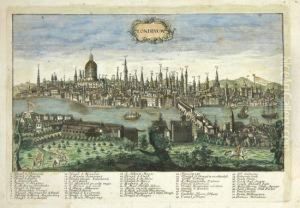Friedrich Bernhard Werner Paintings
Friedrich Bernhard Werner, born in 1690 in Silesia, which was then part of the Kingdom of Prussia and is now located in Poland, was a prolific German artist known for his detailed engravings and topographical views. Werner’s work is particularly significant for its contribution to the documentation and illustration of European cities and landscapes during the 18th century.
Werner initially pursued an education in theology but found his passion in the arts. He traveled extensively throughout Europe, a journey that greatly influenced his work. During his travels, he sketched landscapes and cityscapes, which he later developed into detailed engravings. His itinerant lifestyle allowed him to produce a diverse collection of views from various parts of Europe, including Austria, Italy, Poland, and Germany.
His engravings were widely distributed, often as part of larger collections, and they served as some of the most comprehensive visual records of the time. Werner’s work was characterized by its accuracy and attention to detail, which made his prints valuable for both their artistic merit and their documentary value.
Despite his significant contributions to the visual documentation of European landscapes, Werner's life details are not extensively documented. He passed away in 1776, leaving behind a legacy of work that continues to be of interest to historians, art collectors, and enthusiasts of topography. His engravings remain a precious window into the 18th century, offering insights into the architecture, urban planning, and overall appearance of European locales during that period.

